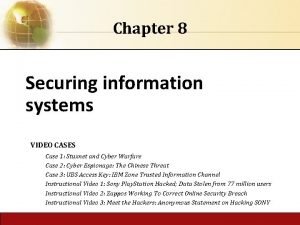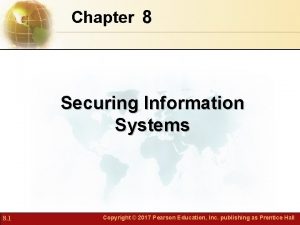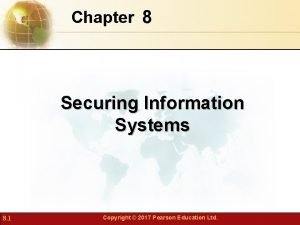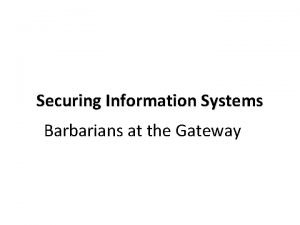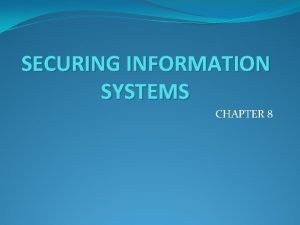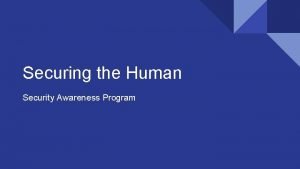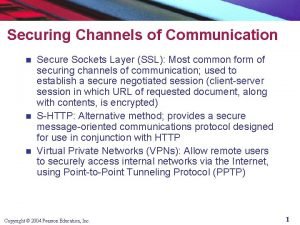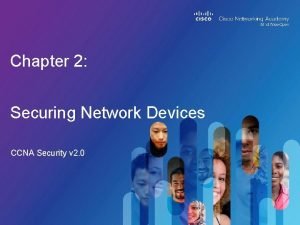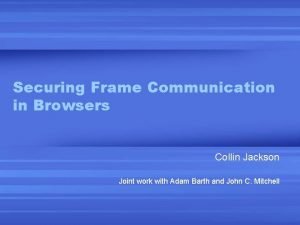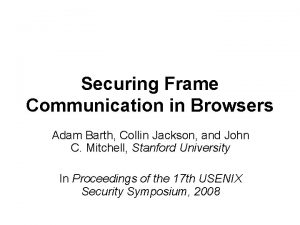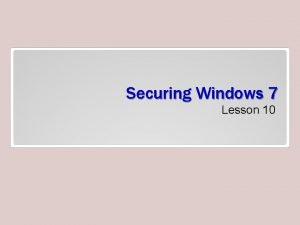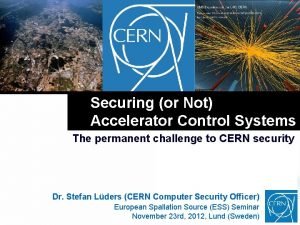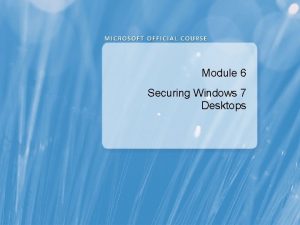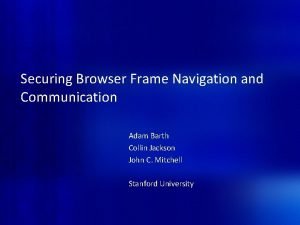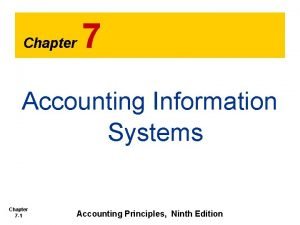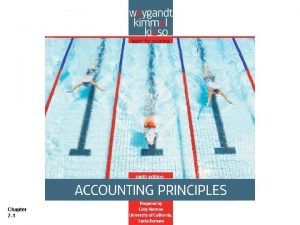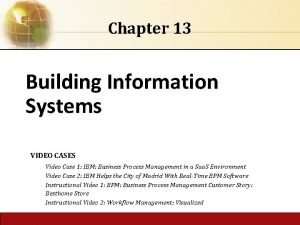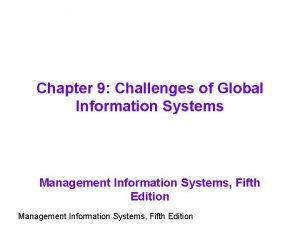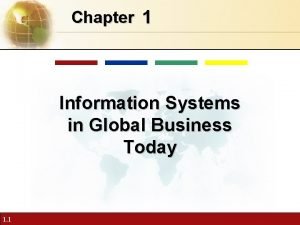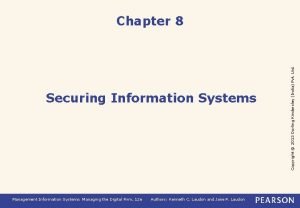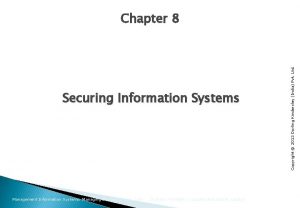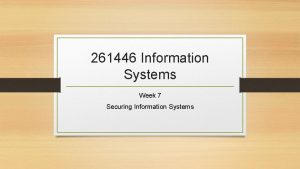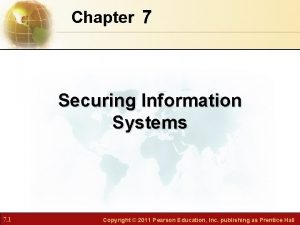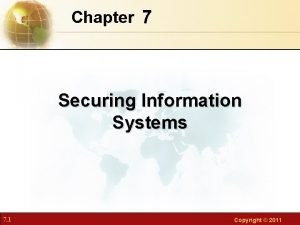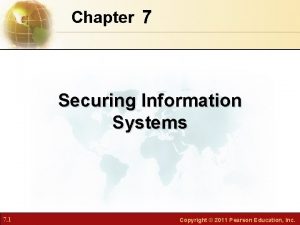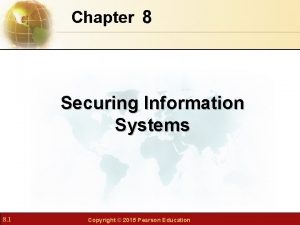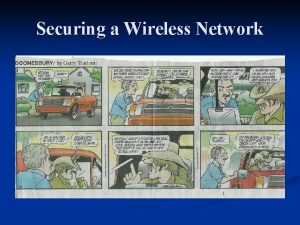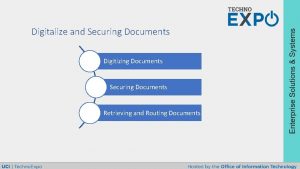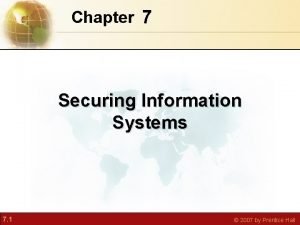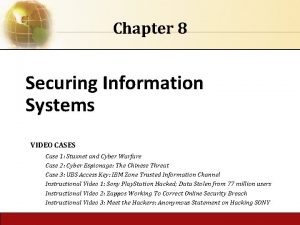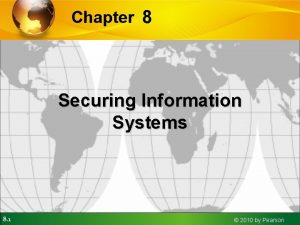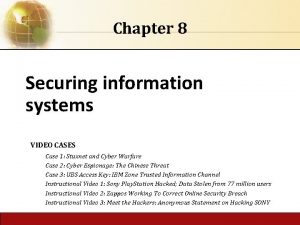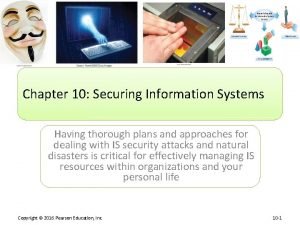Chapter 8 Securing Information Systems 8 1 Copyright






























- Slides: 30

Chapter 8 Securing Information Systems 8. 1 Copyright © 2017 Pearson Education, Inc. publishing as Prentice Hall

Essentials of Management Information Systems Chapter 8 Securing Information Systems STUDENT LEARNING OBJECTIVES • Why are information systems vulnerable to destruction, error, and abuse? • What is the business value of security and control? • What are the components of an organizational framework for security and control? • What are the important tools and technologies for safeguarding information resources? 8. 2 Copyright © 2017 Pearson Education, Inc. publishing as Prentice Hall

Essentials of Management Information Systems Chapter 8 Securing Information Systems Why Are Information Systems Vulnerable? • An unprotected computer connected to Internet may be disabled within seconds • Security: • Policies, procedures, and technical measures used to prevent unauthorized access, alteration, theft, or physical damage to information systems • Controls: • Methods, policies, and organizational procedures that ensure safety of organization’s assets; accuracy and reliability of its accounting records; and operational adherence to management standards 8. 3 Copyright © 2017 Pearson Education, Inc. publishing as Prentice Hall

Essentials of Management Information Systems Chapter 8 Securing Information Systems Why Are Information Systems Vulnerable? Why Systems Are Vulnerable • Hardware problems • Breakdowns, configuration errors, damage from improper use or crime • Software problems • Programming errors, installation errors, unauthorized changes • Disasters • Power failures, flood, fires, and so on • Use of networks, computers outside of firm’s control • Domestic or offshore outsourcing vendors • Mobile devices 8. 4 Copyright © 2017 Pearson Education, Inc. publishing as Prentice Hall

Essentials of Management Information Systems Chapter 8 Securing Information Systems Why Are Information Systems Vulnerable? • Internet vulnerabilities • Network open to anyone • Size of Internet means abuses can have wide impact • Use of fixed Internet addresses with permanent connections to Internet eases identification by hackers • E-mail attachments, file downloading and sharing • E-mail used for transmitting trade secrets • IM messages lack security, can be easily intercepted 8. 5 Copyright © 2017 Pearson Education, Inc. publishing as Prentice Hall

Essentials of Management Information Systems Chapter 8 Securing Information Systems Why Are Information Systems Vulnerable? Malicious Software: Viruses, Worms, Trojan Horses, and Spyware • Malware • Viruses • Rogue software program that attaches itself to other software programs or data files in order to be executed • Worms • Independent computer programs that copy themselves from one computer to other computers over a network • Trojan horses • Software program that appears to be benign but then does something other than expected. 8. 6 Copyright © 2017 Pearson Education, Inc. publishing as Prentice Hall

Essentials of Management Information Systems Chapter 8 Securing Information Systems Why Are Information Systems Vulnerable? Malicious Software: Viruses, Worms, Trojan Horses, and Spyware • SQL injection attacks • Spyware • Small programs install themselves surreptitiously on computers to monitor user Web surfing activity and serve up advertising • Key loggers • Record every keystroke on computer to steal serial numbers, passwords, launch Internet attacks 8. 7 Copyright © 2017 Pearson Education, Inc. publishing as Prentice Hall

Essentials of Management Information Systems Chapter 8 Securing Information Systems Why Are Information Systems Vulnerable? Hackers and Computer Crime • Hackers versus crackers • Activities include: • System intrusion • Theft of goods and services • System damage • Cybervandalism — Intentional disruption, defacement, destruction of Web site or corporate information system 8. 8 Copyright © 2017 Pearson Education, Inc. publishing as Prentice Hall

Essentials of Management Information Systems Chapter 8 Securing Information Systems Why Are Information Systems Vulnerable? Hackers and Computer Crime • Spoofing • Misrepresenting oneself by using fake e-mail addresses or masquerading as someone else • Redirecting Web link to address different from intended one, with site masquerading as intended destination • Sniffer • Eavesdropping program that monitors information traveling over network • Enables hackers to steal proprietary information such as email, company files, and so on 8. 9 Copyright © 2017 Pearson Education, Inc. publishing as Prentice Hall

Essentials of Management Information Systems Chapter 8 Securing Information Systems Why Are Information Systems Vulnerable? • Patches: Small pieces of software to repair flaws released by vendors • However, amount of software in use, and shear number of malware programs, can mean exploits are created faster than patches can be released 8. 10 • Large number of software applications • Disparate operating systems • Poor management of patches Copyright © 2017 Pearson Education, Inc. publishing as Prentice Hall

Essentials of Management Information Systems Chapter 8 Securing Information Systems What is the Business Value of Security and Control? • Failed computer systems can lead to significant or total loss of business function. • Firms now more vulnerable than ever. • A security breach may cut into firm’s market value almost immediately. • Inadequate security and controls also bring forth issues of liability. 8. 11 Copyright © 2017 Pearson Education, Inc. publishing as Prentice Hall

Essentials of Management Information Systems Chapter 8 Securing Information Systems What are the components of an organizational framework for security and control? • Information systems controls • General controls • Govern design, security, and use of computer programs and security of data files in general throughout organization’s information technology infrastructure. • Apply to all computerized applications. • Combination of hardware, software, and manual procedures to create overall control environment. 8. 12 Copyright © 2017 Pearson Education, Inc. publishing as Prentice Hall

Essentials of Management Information Systems Chapter 8 Securing Information Systems Components of an organizational framework for security and control • Types of general controls • Software controls • Hardware controls • Computer operations controls • Data security controls • Implementation controls • Administrative controls 8. 13 Copyright © 2017 Pearson Education, Inc. publishing as Prentice Hall

Essentials of Management Information Systems Chapter 8 Securing Information Systems Components of an organizational framework for security and control • Application controls • Specific controls unique to each computerized application, such as payroll or order processing. • Include both automated and manual procedures. • Ensure that only authorized data are completely and accurately processed by that application. • Include: • Input controls • Processing controls • Output controls 8. 14 Copyright © 2017 Pearson Education, Inc. publishing as Prentice Hall

Essentials of Management Information Systems Chapter 8 Securing Information Systems Components of an organizational framework for security and control • Risk assessment • Determines level of risk to firm if specific activity or process is not properly controlled • • 8. 15 Types of threat Probability of occurrence during year Potential losses, value of threat Expected annual loss EXPOSURE PROBABILITY LOSS RANGE EXPECTED ANNUAL LOSS Power failure 30% $5 K - $200 K $30, 750 Embezzlement 5% $1 K - $50 K $1, 275 User error 98% $200 - $40 K $19, 698 Copyright © 2017 Pearson Education, Inc. publishing as Prentice Hall

Essentials of Management Information Systems Chapter 8 Securing Information Systems Components of an organizational framework for security and control • Security policy • Ranks information risks • Identifies acceptable security goals • Identifies mechanisms for achieving these goals • Drives other policies • Acceptable use policy (AUP) • Authorization policies • Provisions for identity management 8. 16 Copyright © 2017 Pearson Education, Inc. publishing as Prentice Hall

Essentials of Management Information Systems Chapter 8 Securing Information Systems Components of an organizational framework for security and control • Identity management • Business process and technologies for identifying valid users of system • Creates different levels or roles of system user and access • Allows each user access only to those portions of system that user role 8. 17 Copyright © 2017 Pearson Education, Inc. publishing as Prentice Hall

Essentials of Management Information Systems Chapter 8 Securing Information Systems Components of an organizational framework for security and control Security Profiles for a Personnel System Figure 8. 3 These two examples represent two security profiles or data security patterns that might be found in a personnel system. Depending on the security profile, a user would have certain restrictions on access to various systems, locations, or data in an organization. 8. 18 Copyright © 2017 Pearson Education, Inc. publishing as Prentice Hall

Essentials of Management Information Systems Chapter 8 Securing Information Systems Components of an organizational framework for security and control Disaster Recovery Planning and Business Continuity Planning • Disaster recovery planning: Devises plans for restoration of disrupted services • Business continuity planning: Focuses on restoring business operations after disaster • Both types of plans needed to identify firm’s most critical systems • Business impact analysis to determine impact of an outage • Management must determine which systems restored first 8. 19 Copyright © 2017 Pearson Education, Inc. publishing as Prentice Hall

Essentials of Management Information Systems Chapter 8 Securing Information Systems Components of an organizational framework for security and control The Role of Auditing • MIS audit • Examines firm’s overall security environment as well as controls governing individual information systems • Reviews technologies, procedures, documentation, training, and personnel • May even simulate disaster to test response of technology, IS staff, other employees • Lists and ranks all control weaknesses and estimates probability of their occurrence. • Assesses financial and organizational impact of each threat 8. 20 Copyright © 2017 Pearson Education, Inc. publishing as Prentice Hall

Essentials of Management Information Systems Chapter 8 Securing Information Systems What are the most important tools and technologies for safeguarding information resources? Sample Auditor’s List of Control Weaknesses Figure 8. 4 This chart is a sample page from a list of control weaknesses that an auditor might find in a loan system in a local commercial bank. This form helps auditors record and evaluate control weaknesses and shows the results of discussing those weaknesses with management, as well as any corrective actions taken by management. 8. 21 Copyright © 2017 Pearson Education, Inc. publishing as Prentice Hall

Essentials of Management Information Systems Chapter 8 Securing Information Systems Most important tools and technologies for safeguarding information resources Identity Management and Authentication • Authentication • Password systems • Tokens • Smart cards • Biometric authentication • Fingerprints, irises, voices 8. 22 Copyright © 2017 Pearson Education, Inc. publishing as Prentice Hall

Essentials of Management Information Systems Chapter 8 Securing Information Systems Most important tools and technologies for safeguarding information resources Firewalls, Intrusion Detection Systems, and Antivirus Software • Firewall: • Combination of hardware and software that prevents unauthorized access to network • Technologies include: • Packet filtering • Stateful inspection • Network address translation (NAT) • Application proxy filtering 8. 23 Copyright © 2017 Pearson Education, Inc. publishing as Prentice Hall

Essentials of Management Information Systems Chapter 8 Securing Information Systems Most important tools and technologies for safeguarding information resources A Corporate Firewall Figure 8. 5 The firewall is placed between the firm’s private network and the public Internet or another distrusted network to protect against unauthorized traffic. 8. 24 Copyright © 2017 Pearson Education, Inc. publishing as Prentice Hall

Essentials of Management Information Systems Chapter 8 Securing Information Systems Most important tools and technologies for safeguarding information resources • Intrusion detection systems: • Monitor hot spots on corporate networks to detect and deter intruders. • Examine events as they are happening to discover attacks in progress. • Antivirus and antispyware software: • Check computers for presence of malware and can often eliminate it as well. • Require continual updating. • Unified Threat Management (UTM) systems 8. 25 Copyright © 2017 Pearson Education, Inc. publishing as Prentice Hall

Essentials of Management Information Systems Chapter 8 Securing Information Systems Most important tools and technologies for safeguarding information resources Securing Wireless Networks • WEP security can be improved: • Activating it • Assigning unique name to network’s SSID • Using it with VPN technology • Wi-Fi Alliance finalized WPA 2 specification, replacing WEP with stronger standards • Continually changing keys • Encrypted authentication system with central server 8. 26 Copyright © 2017 Pearson Education, Inc. publishing as Prentice Hall

Essentials of Management Information Systems Chapter 8 Securing Information Systems Most important tools and technologies for safeguarding information resources Encryption and Public Key Infrastructure • Encryption: • Transforming text or data into cipher text that cannot be read by unintended recipients • Two methods for encryption on networks • Secure Sockets Layer (SSL) and successor Transport Layer Security (TLS) • Secure Hypertext Transfer Protocol (S-HTTP) 8. 27 Copyright © 2017 Pearson Education, Inc. publishing as Prentice Hall

Essentials of Management Information Systems Chapter 8 Securing Information Systems Most important tools and technologies for safeguarding information resources Encryption and Public Key Infrastructure • Two methods of encryption • Symmetric key encryption • Sender and receiver use single, shared key • Public key encryption • Uses two, mathematically related keys: public key and private key • Sender encrypts message with recipient’s public key • Recipient decrypts with private key 8. 28 Copyright © 2017 Pearson Education, Inc. publishing as Prentice Hall

Essentials of Management Information Systems Chapter 8 Securing Information Systems Most important tools and technologies for safeguarding information resources Public Key Encryption A public key encryption system can be viewed as a series of public and private keys that lock data when they are transmitted and unlock the data when they are received. The sender locates the recipient’s public key in a directory and uses it to encrypt a message. The message is sent in encrypted form over the Internet or a private network. When the encrypted message arrives, the recipient uses his or her private key to decrypt the data and read the message. Figure 8. 6 8. 29 Copyright © 2017 Pearson Education, Inc. publishing as Prentice Hall

All rights reserved. No part of this publication may be reproduced, stored in a retrieval system, or transmitted, in any form or by any means, electronic, mechanical, photocopying, recording, or otherwise, without the prior written permission of the publisher. Printed in the United States of America. 8. 30 Copyright © 2017 Pearson Education, Inc. publishing as Prentice Hall
 Securing information systems
Securing information systems Chapter 8 securing information systems
Chapter 8 securing information systems Chapter 8 securing information systems
Chapter 8 securing information systems Chapter 8 securing information systems
Chapter 8 securing information systems Chapter 8 securing information systems
Chapter 8 securing information systems Securing information system
Securing information system Securing information systems
Securing information systems Chapter 8 securing the republic summary
Chapter 8 securing the republic summary Sans mgt 433
Sans mgt 433 The most common form of securing channels is through
The most common form of securing channels is through Securing network devices
Securing network devices Guninski attack
Guninski attack Securing frame communication in browsers
Securing frame communication in browsers Securing windows 7
Securing windows 7 Securing
Securing Securing windows 7
Securing windows 7 Basic scalp manipulation
Basic scalp manipulation Securing the northwest territory
Securing the northwest territory Adam secure browser
Adam secure browser Function of information system with diagram
Function of information system with diagram Chapter 7 accounting information systems
Chapter 7 accounting information systems Chapter 7 accounting information systems
Chapter 7 accounting information systems Chapter 13 building information systems
Chapter 13 building information systems Introduction to information systems 6th edition
Introduction to information systems 6th edition Fundamental of information system
Fundamental of information system Global information system
Global information system Chapter 4 ethical issues
Chapter 4 ethical issues Information systems in global business today
Information systems in global business today Introduction to mis
Introduction to mis 4 components of an information system
4 components of an information system Chapter 7 accounting information systems
Chapter 7 accounting information systems


